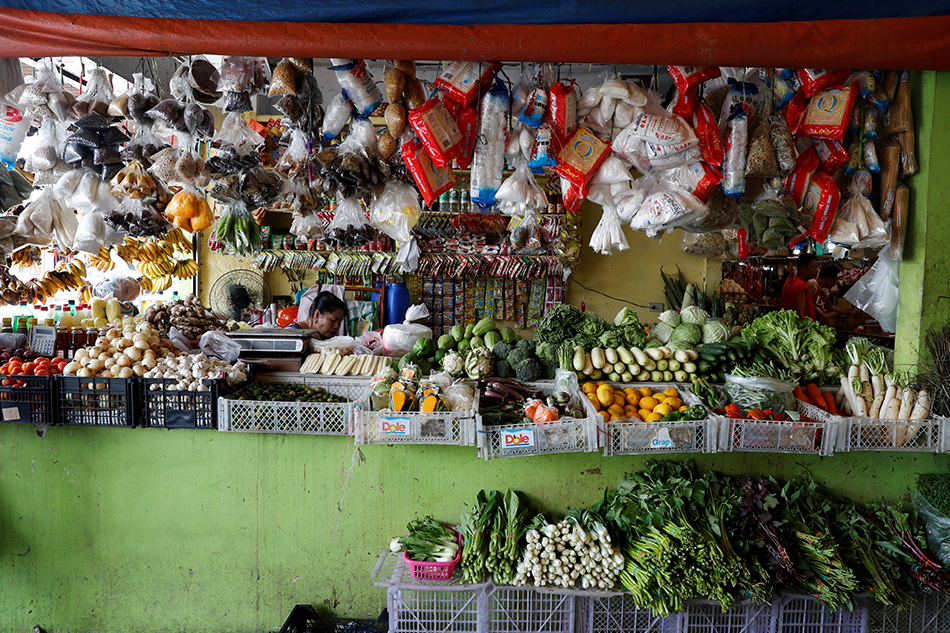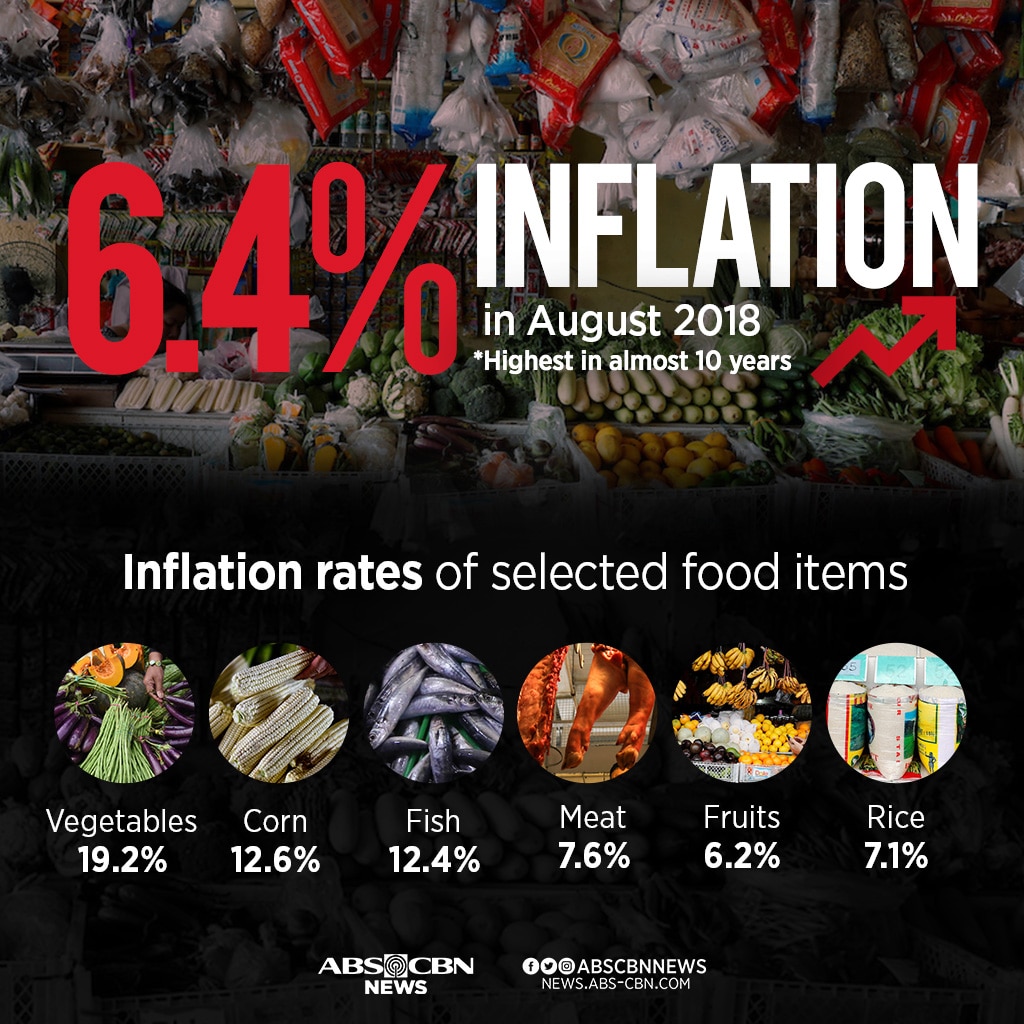'Shrinkflation' creeps into carinderia plates as prices soar | ABS-CBN
ADVERTISEMENT

Welcome, Kapamilya! We use cookies to improve your browsing experience. Continuing to use this site means you agree to our use of cookies. Tell me more!
'Shrinkflation' creeps into carinderia plates as prices soar
'Shrinkflation' creeps into carinderia plates as prices soar
Jessica Fenol and Joel Guinto,
ABS-CBN News
Published Sep 06, 2018 12:09 PM PHT
|
Updated Sep 06, 2018 01:08 PM PHT
MANILA -- Bistek tagalog and kare-kare await regulars at Joy Gasmin's roadside eatery at lunch time, alongside most viands except chopsuey, as fast-rising vegetable prices forced her to revamp her menu.
MANILA -- Bistek tagalog and kare-kare await regulars at Joy Gasmin's roadside eatery at lunch time, alongside most viands except chopsuey, as fast-rising vegetable prices forced her to revamp her menu.
Gasmin also admitted to reducing serving sizes, including her best-selling bulalo or beef marrow soup, to keep prices steady.
Gasmin also admitted to reducing serving sizes, including her best-selling bulalo or beef marrow soup, to keep prices steady.
"Pag nagtaas kasi ng presyo, magrereklamo ang mga customer (If we increase prices, customers will complain)," Gasmin, 36, told ABS-CBN News.
"Pag nagtaas kasi ng presyo, magrereklamo ang mga customer (If we increase prices, customers will complain)," Gasmin, 36, told ABS-CBN News.
Reduced portions, what economists call "shrinkflation," is also finding its way into mall food carts. A shawarma vendor admitted to being told by her boss to go easy on the onions.
Reduced portions, what economists call "shrinkflation," is also finding its way into mall food carts. A shawarma vendor admitted to being told by her boss to go easy on the onions.
ADVERTISEMENT
"Ang sabi sa amin, alalay sa sibuyas kasi nagtataas. Hindi naman direkta sinabing bawasan pero alalay," said the vendor, who asked not to be identified.
"Ang sabi sa amin, alalay sa sibuyas kasi nagtataas. Hindi naman direkta sinabing bawasan pero alalay," said the vendor, who asked not to be identified.
(We were told to go easy on the onions because prices have gone up. We weren't asked directly to reduce the portions, but go easy.)
(We were told to go easy on the onions because prices have gone up. We weren't asked directly to reduce the portions, but go easy.)
Food inflation zoomed to 8.5 percent in August, outpacing the headline rate of 6.4 percent. Both are at their fastest in nearly 10 years based on 2012 prices. Vegetable prices alone rose 19.2 percent.
Food inflation zoomed to 8.5 percent in August, outpacing the headline rate of 6.4 percent. Both are at their fastest in nearly 10 years based on 2012 prices. Vegetable prices alone rose 19.2 percent.
Economic managers on Tuesday announced the "immediate release" of 4.6 million sacks of state-subsidized rice and the importation of 10 million more sacks until 2019 to help tame prices. This is on top of a push to tax imports of the staple grain in place of import quotas.
Economic managers on Tuesday announced the "immediate release" of 4.6 million sacks of state-subsidized rice and the importation of 10 million more sacks until 2019 to help tame prices. This is on top of a push to tax imports of the staple grain in place of import quotas.
FOOD LEADS PRICE SPIKES
Food and beverage inflation of 8.5 percent in August was nearly triple the 2.9 percent posted during the same month in 2017 and was 1.4 points higher than the previous month, according to the Philippine Statistics Authority.
Food and beverage inflation of 8.5 percent in August was nearly triple the 2.9 percent posted during the same month in 2017 and was 1.4 points higher than the previous month, according to the Philippine Statistics Authority.
ADVERTISEMENT
Rice, the main driver of food prices, saw inflation of 7.1 percent in August. Vegetable prices rose 19.2 percent, corn by 12.6 percent, fish by 12.4 percent, meat by 7.6 percent and fruits by 6.2 percent.
Rice, the main driver of food prices, saw inflation of 7.1 percent in August. Vegetable prices rose 19.2 percent, corn by 12.6 percent, fish by 12.4 percent, meat by 7.6 percent and fruits by 6.2 percent.
To stave off price increases, businessmen sometimes reduce the sizes of their products in what economists call "shrinkflation." It was observed as early as 1916 in the US where bread sizes were shrunken down to keep prices steady.
To stave off price increases, businessmen sometimes reduce the sizes of their products in what economists call "shrinkflation." It was observed as early as 1916 in the US where bread sizes were shrunken down to keep prices steady.
Like Gasmin, 48-year-old Gina Rocabo also removed chopsuey from her menu and stopped offering free chilies, which her regulars grind into soy sauce and fish sauce.
Like Gasmin, 48-year-old Gina Rocabo also removed chopsuey from her menu and stopped offering free chilies, which her regulars grind into soy sauce and fish sauce.
She also reduced chili in her dinuguan or blood stew.
She also reduced chili in her dinuguan or blood stew.
"Sa 18 years ng karinderya ko ngayon lang nangayari ito. Sobrang mahal ng sili kaya hindi na kami nagbibigay," she said.
"Sa 18 years ng karinderya ko ngayon lang nangayari ito. Sobrang mahal ng sili kaya hindi na kami nagbibigay," she said.
ADVERTISEMENT
(In my 18 years of running a carinderia, this is the first time this happened. Chili is so expensive, I can't give it away for free.)
(In my 18 years of running a carinderia, this is the first time this happened. Chili is so expensive, I can't give it away for free.)
BIPARTISAN RESPONSE
Forty-five percent of Filipinos flagged inflation as a "most urgent national concern" and another 50 percent cited higher wages, according to a March 23 to 28 poll by Pulse Asia.
Forty-five percent of Filipinos flagged inflation as a "most urgent national concern" and another 50 percent cited higher wages, according to a March 23 to 28 poll by Pulse Asia.
Ninety-eight percent said goods that they buy became "more expensive" compared to the start of 2018, a separate Pulse Asia poll conducted during the same period showed.
Ninety-eight percent said goods that they buy became "more expensive" compared to the start of 2018, a separate Pulse Asia poll conducted during the same period showed.
Ninety-two percent said food prices rose, with 81 percent saying that rice prices increased, Pulse Asia said.
Ninety-two percent said food prices rose, with 81 percent saying that rice prices increased, Pulse Asia said.
Faster-than-expected inflation has prompted both the administration and the opposition to suggest measures to curb price spikes.
Faster-than-expected inflation has prompted both the administration and the opposition to suggest measures to curb price spikes.
ADVERTISEMENT
Speaker Gloria Macapagal-Arroyo in July met with Duterte's economic managers to discuss possible responses. When Arroyo was president, inflation reached 7.2 percent in February 2009, according to ABS-CBN Data Analytics.
Speaker Gloria Macapagal-Arroyo in July met with Duterte's economic managers to discuss possible responses. When Arroyo was president, inflation reached 7.2 percent in February 2009, according to ABS-CBN Data Analytics.
Vice President Leni Robredo and her Liberal Party filed bills in the Senate and the House of Representatives to suspend further increases in the fuel excise tax rate.
Vice President Leni Robredo and her Liberal Party filed bills in the Senate and the House of Representatives to suspend further increases in the fuel excise tax rate.
Government economic managers said inflation would peak in August and September, after which it would taper off and fall back to the Bangko Sentral's 2 to 4 percent target.
Government economic managers said inflation would peak in August and September, after which it would taper off and fall back to the Bangko Sentral's 2 to 4 percent target.
Until prices ease, eatery owners like Rocabo said she would find more ways to cut costs.
Until prices ease, eatery owners like Rocabo said she would find more ways to cut costs.
"Tipid tipid na lang dahil baka hindi na makakapag-aral ang mga bata," she said.
"Tipid tipid na lang dahil baka hindi na makakapag-aral ang mga bata," she said.
ADVERTISEMENT
(I need to be thrifty, otherwise, my children can't go to school.)
(I need to be thrifty, otherwise, my children can't go to school.)
ADVERTISEMENT
ADVERTISEMENT





